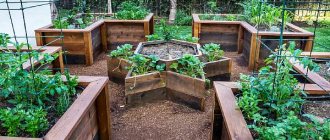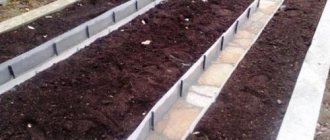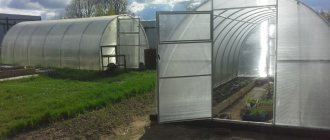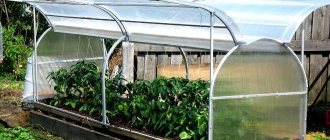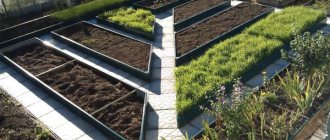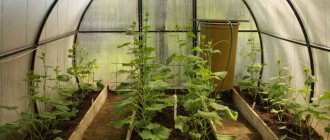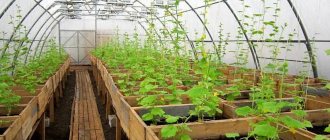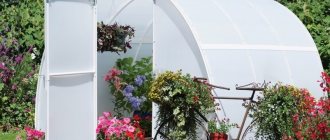When creating the design of a garden plot and allocating areas for planting various crops, the design of beds, paths and flower beds plays a significant role. Wood is perhaps the most accessible and most “obedient” material. We offer examples of how to make not only practical, but also aesthetic beds from boards with your own hands, in detail in the article.
High beds allow you to create the most favorable conditions for growing vegetables, herbs and berries in small areas
Advantages and disadvantages
Garden beds on the site are not only an aesthetically attractive design, but also useful. A raised bed can be built to grow a variety of crops. However, these are not the main advantages of this solution; there are others:
- Early germination and good yield - these indicators are possible with garden beds made from boards. To achieve maximum effect, the bed must be properly fertilized.
- Duration of operation. If the boards used are pre-treated with certain products and impregnations, then the garden beds will last quite a long time - up to 10 years.
- Low price is perhaps the most attractive aspect of all construction work. To construct the structure, you can use the remaining lumber after the construction of any building. When starting to build a terrace or house from lumber, it is wiser to purchase additional wood in advance for building beds.
- Simple construction technology. Making a wooden box yourself will not be difficult even for those people who are far from carpentry. You just need to know the sequence of actions.
- Simplicity and ease of maintenance. Wooden beds are easy to care for, especially if all weeds are removed before building them.
Assembling the box is quite simple
Despite the multiple advantages of this solution, it is not without its drawbacks. These include the need for annual maintenance of the manufactured wooden structure. In order for the box to last longer, it needs to be treated periodically.
Step-by-step production
In order to properly make raised beds at the dacha with your own hands, the following materials and tools are prepared:
- boards;
- beam;
- construction mesh;
- primer;
- self-tapping screws;
- shovel;
- roulette;
- building level;
- Circular Saw.
The timber is sawn into pieces and, together with the boards, is treated with a protective material. Particular attention is paid to the lower elements that are in direct contact with the ground.
Choose a convenient place that is well lit during the day. The soil is being prepared. All stones and debris are removed. If the earth is dug up, it will better allow moisture to pass through it. If the chernozem is highly hard, you need to remove the top layer of turf and then assemble the structure.
2 boxes are knocked down one by one. At the ends of the boards, 2 cuts are made at an angle of 45 degrees. These places are placed next to each other, and fastening is carried out using a beam, which is placed in the corner. Another way is overlap. In this case, the connection is made with self-tapping screws.
In order to give rigidity to the long side, a spacer is placed in the middle. Both boxes are connected together using bars. They are sawn off larger than the height of the walls, so they protrude by 10 cm.
As decoration, boards are installed horizontally on top. They also serve as railings.
What materials are best to use
The box can be constructed from any lumber left over after construction. For example, from decking boards, lining and other things. However, if we are talking about purchasing lumber for the boxes being constructed, in this case it is worth paying attention to one nuance, namely, what kind of wood the board is made of.
Before installation
Oak or ash
A box made of ash or oak will last as long as possible. Of course, such lumber “bites” in terms of cost, but the good quality of the board more than compensates for this.
Pine
Pine is beneficial in terms of cost and subsequent processing. But it is worth considering that untreated pine quickly breaks down and rots in damp soil.
Diagram with dimensions
Larch or cedar
Lumber from cedar or larch is best suited for making boxes. These types of wood are initially richly impregnated with resin. Due to this, they do not always need to be processed. They are already able to lie in the ground for a long time without consequences. An additional advantage of this solution is the price: it does not hit the wallet.
Determination of dimensions
To create environmentally friendly wooden boxes, you need to focus on the parameters of the future design in accordance with the initial data and assigned tasks. This is the first thing to do.
The size of the land plot depends on the crop that is supposed to be planted on it. The longer the bed, the more additional supports will be needed to strengthen the walls. The width must correspond to the characteristics of the agricultural technology of the crop. For ease of work, the plants are placed in two rows.
The height of the structure is a special matter. It depends on the following factors:
- Soil characteristics. On fertile lands there is no reason to build high sides. But on rocky soil or depleted soils such structures are justified; they are raised to a level of 0.3 to 0.5 m.
- If you plan to sow radishes or lettuce to get an early harvest, the height of the box should be made higher than 0.2 m.
- To grow potatoes, the bed should not be lower than 0.4 m.
- If you need to protect plants from return frosts, you can build a warm bed, the height of which will be 0.5 m.
Beds higher than 0.5m provide protection for plants from the cold
Wood protection
Whatever type of wood the board is made of, it still needs to be processed before subsequent use.
The only exceptions are larch and cedar boards. The service life of the box will depend on this action. However, wood should be processed with extreme caution so as not to subsequently contaminate the soil.
The best option for processing lumber is coating with lime. The best results are shown by impregnation with the preparation “Senezh” and similar ones. But their use will entail additional financial costs.
Manufacturing diagram and sequence
Another good option would be to coat the wood with a double coat of paint, preferably oil-based. This will also give the appearance of additional framing. This coating will not harm plants or pollute the soil. However, it is worth choosing environmentally friendly paint, especially if the frame is being built in a greenhouse.
There is also one more nuance - during the painting process it is not advisable to paint the ends of the boards. It is through these areas that the tree will breathe and get rid of accumulated moisture, especially in a greenhouse. If you do this, the tree will rot much faster.
The photo below shows the installation of boxes.
Maintenance aisles must be taken into account
What fencing size to choose
Basically, rectangular formworks for soil are made, although they can be triangular, diamond-shaped or square. It is very important to determine the correct dimensions. Correctly sized formwork is easier and more convenient to maintain.
So, boxes of the following sizes are made for the beds:
- It is very important to calculate the height correctly. A deliberately erroneous opinion that many gardeners adhere to: higher means better. Of course, such formworks have certain advantages, but there is a limit to everything. Making raised sides (75 cm) makes sense for “insulated beds” in which filler is laid in layers. Also at this height you can assemble a bed for cucumbers (for cucumber seedlings), tomatoes and other things. For ordinary raised fences, a height of 20 cm is sufficient. A high box is disadvantageous because a lot of wood is consumed in its manufacture. Moreover, during the cold season, the middle layer of earth inside the structure will freeze and expand, causing the destruction of the entire frame.
- The width of the structure determines the convenience of subsequent work. There is an opinion among gardeners that the width of the bed should be equal to half the height of human height. This parameter is 95-120 cm. And indeed, with such parameters, the gardener, bending over, will be able to reach from the side to the middle of the bed.
- Length is a parameter that has no restrictions. However, it is worth considering that if you make the side too long, its middle loses its rigidity. In this case, the middle of the structure should be reinforced with rigid guides. The optimal length is from 4.5 to 7 m.
It is also very important to take into account the presence of paths in this area.
The photo shows triangular shaped boxes.
The variety of possible shapes will satisfy the imagination of any gardener
The frame must be constructed taking into account the 45-centimeter path along which you will move around the summer cottage.
Possible mistakes
Not only a carpenter can build a wooden box. But a common mistake gardeners make when arranging beds is the lack of impregnation of the boards. Processing is a mandatory step, which is responsible for the durability of the structure.
Summer residents often forget about the mesh that is attached to the bottom of the garden bed. Metal mesh is the key to rodent control.
Layout diagram
The most basic mistake gardeners make is that they pay attention only to the area, shape and boundaries of the paths when building beds from boards. However, not only these parameters should be taken into account. The location of the structure in relation to the lighting is of great importance.
Strawberries and other fruits and vegetables require a certain arrangement of structures, since the yield depends on this. For example, strawberry beds should be built in the full sun. This will promote crop growth.
Layout diagram in the greenhouse
It is correct to make beds for strawberries in an orientation from north to south. In this case, before lunch, the plants will be perfectly illuminated on one side, and after lunch on the other.
It is also possible to place structures on a summer cottage from east to west. On the north side, you can plant a type of plant that loves shade. An example of the arrangement of boxes is shown in the photo below.
It is necessary to correctly position the structures relative to the sun
Reasons to choose raised beds - decorative and practical value
The frame protects from excess dirt. The soil does not crumble, does not stick to shoes when wet, and does not get pulled along the paths. The structures are quickly installed and do not affect the composition of the soil. The height of the beds depends on the crops grown. Carrots are planted in a high bed. For leafy vegetables, herbs, and vegetable crops that form upland root crops, multi-tiered structures decorating the site are suitable.
Raised beds compare favorably with classic ones, and they are not at all difficult to make.
Labor costs for caring for crops are reduced. There is no need to dig up the beds; just loosen them before planting. If necessary, the soil is fertilized. High beds are especially necessary:
- When groundwater levels are low, when plant roots are suppressed, root rot develops.
- On infertile lands, where there is no need to fertilize the entire area, it is enough to prepare the soil in boxes.
- Problems with the musculoskeletal system, then the load on the spine is reduced.
Reliable structures can easily endure wintering, the soil is frozen to its full depth, and disinfection occurs. The substrate thaws quickly in winter and warms up on sunny days. An irrigation system is installed in the frame; there is no need to carry watering cans. Thanks to this regime, crop yields significantly increase.
It’s nice to admire a neat vegetable garden with even beds
The number of weeds is reduced. Geotextiles are laid between the beds and the grooves are filled with sawdust.
Boxes can be used as greenhouses. Place biofuel at the bottom - rotting components release heat. Warmth-loving crops growing in such a smart bed are not afraid of frost. Without shelters you can grow cucumbers, zucchini, and pumpkins. Mobile film shelters can be easily mounted on the frames and removed in hot weather.
Any type of wood is suitable for making your own raised beds - from slabs to timber
The choice of wood for garden beds depends only on the costs you are willing to incur.
How many boxes to make?
Before we begin to consider the question of how to make a garden bed, let’s decide how many of them to make. In fact, the amount solely depends on the number of crops grown and the area of land.
It should also be taken into account that, no matter how many boxes you plan to make, it is advisable to build one more in reserve.
This is what will go into the compost. The made box will remain empty all summer. However, in the fall, when the box is filled to the top with organic fertilizers, a layer of soil is added on top, on which green manure is sown. You can choose peas or mustard.
After wintering, this formwork will become an ideal site for planting tomatoes or cucumbers, as the soil will be saturated with useful microelements and minerals.
The photo shows a small box.
Rectangular box made of boards
Plastic structures
Products made from polymer elements favorably emphasize the perimeter of plantings. In addition, plastic beds come in different colors and textures, so you can create a unique landscape design.
Plastic is a fairly rigid barrier, which subsequently separates the landing zone.
The plastic elements are flexible enough to give the structure any shape.
Due to the fact that plastic beds do not absorb moisture and are not affected by temperature changes and direct sunlight, they can be collected in different climatic zones.
In the courtyard
The garden plastic board used can be of different textures:
- brick;
- natural stone;
- wood texture;
- metal and much more.
It must be admitted that beds made of PVC boards are much more durable than those made of lumber. They are reliably protected from rotting.
Also, if desired, the plastic box can be moved from place to place, which cannot be done when the structure is stone, brick or iron. In fact, plastic fences are mobile structures that do not require specific maintenance.
Design diagram
In addition to the above advantages, plastic parts have the following features:
- Simple and relatively quick installation. Using plastic elements for the garden bed, you will eventually be able to assemble a box in the shortest possible time. The plastic does not need to be further processed or placed on a bonding material. You just need to create a configuration of a suitable shape, and then fill it with fertile soil.
- Polyvinyl chloride is characterized by increased wear resistance and practicality. Structures made from this material are designed for a fairly long service life. Moreover, polyvinyl chloride is a lightweight material, which makes it possible to design multi-tiered country houses. If you make beds for strawberries, tomatoes or cucumbers from polyvinyl chloride with your own hands, then this will be an excellent solution.
- A huge selection of plastic models and excellent decorative qualities. You can choose elements of different textures, which will allow you to decorate your summer cottage and give it a zest.
- Mobility. If desired, decorative composite fencing can be quickly and easily dismantled or moved. There is corresponding video material on this topic on YouTube.
- No additional care. Unlike the same wood box, a PVC border does not require special processing. Over time, it does not need to be varnished or painted, since PVC does not absorb moisture and does not deteriorate when exposed to direct sunlight.
Options for wooden borders
Creating beds without boards
How to make garden beds without boards? In fact, it’s no more difficult than using planks. Any summer resident can decide at his own discretion what to build the box from. But it is worth considering that the subsequent technology for creating the box depends on the characteristics of the material.
Such structures can be created from the following materials:
- Brick, stone or border are used for the garden bed. These materials are used for boxes in greenhouses, as they have the ability to retain heat for a long time. These products look quite aesthetically pleasing and have a long service life. However, the assembly procedure for such structures requires much more time, and dismantling can cause certain difficulties.
- Vine. This material is available, it can be collected in the forest or forest plantation. Due to the flexibility of the vine, the structure can be given absolutely any shape. But the short lifespan of this material puts it at a disadvantage compared to others. It is especially not recommended to use the vine in a greenhouse.
- Metal sheets. These designs are portable and convenient. They can be used both in the greenhouse and outdoors, making them versatile. Of course, it is best to use stainless metals for these purposes.
- How else to make raised beds without boards? It's simple. You can use ordinary slate. Inexpensive material from which it is quite easy to assemble the necessary structures. However, slate is a very fragile material, this should also be taken into account during assembly.
The video below shows how to make beds from slate.
Preliminary processing
Before starting work, the material is impregnated. This increases its service life by several years. The main thing is that the solution does not contain toxins. Wood is hygroscopic. She passes all the elements through herself. In this way, toxins will enter the soil.
Processing is carried out with the following substances:
- Sunflower oil and propolis. The ingredients are mixed in a 3:1 ratio. The solution is shaken. The surface is cleaned of dirt and dried. Then the mixture is applied to the wood twice with a sponge. There is protection against rot, fungus, and mold. However, the composition does not last long and after some time the procedure must be repeated.
- Beeswax. Refers to expensive but effective means. It covers the entire surface.
- Copper sulfate. The solution is purchased ready-made. Apply onto a sponge and apply to the surface in a circular motion.
- Lime. Refers to the most accessible method. Lime is diluted in water and the surfaces of the boards are whitened with a brush.
- Finnish method. The paste is being prepared. 10 liters of water are brought to a boil. During this time, 800 g of flour, 0.5 kg of salt, 1.5 kg of copper sulfate and the same amount of dry lime are gradually added. The boards are coated with a hot compound.
It is especially important to process wood in a greenhouse. Due to high humidity, it quickly begins to rot. Ants often live in it.
